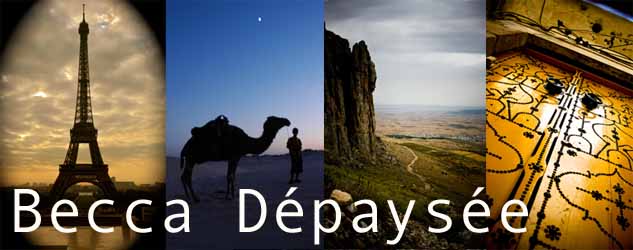 At one point last semester, my grammar teacher launched into an unprovoked rant about how Americans are too out of touch with the means of food production and don't have enough respect for their farmers and other small family businesses. In contrast, she held that (and my commentary is in parentheses) the French are much more aware and appreciative of their farmers (in a distant, idyllically reverent way that no longer quite reflects the growing industrialization of the market...they're turning more and more to frozen and processed foods) and their animals and produce (less pesticides, more markets, fresher and more organic products, yes--but they still do quite a bit of international produce importing and you can't tell me that force feeding a duck to make foie gras out of its liver is much kinder than cooping up chickens). She also said that the French have a greater appreciation for regional products, even if they might be more expensive than the big box brand. This last one, at least, is very true. As is evidenced by the "appellation d'origine contrôlée" seal (which is the reason why America produces sparkling white wine instead of Champagne and blue cheese instead of Roquefort) the French are very cognizant and fiercely protective of their regional products. Our teacher's proof for her claims was the French love of the annual "Salon d'Agriculture", which is essentially a classier version of a state fair that's been drawing huge hoards of Parisians (and an obligatory appearance from the President) for the last fifty years.
At one point last semester, my grammar teacher launched into an unprovoked rant about how Americans are too out of touch with the means of food production and don't have enough respect for their farmers and other small family businesses. In contrast, she held that (and my commentary is in parentheses) the French are much more aware and appreciative of their farmers (in a distant, idyllically reverent way that no longer quite reflects the growing industrialization of the market...they're turning more and more to frozen and processed foods) and their animals and produce (less pesticides, more markets, fresher and more organic products, yes--but they still do quite a bit of international produce importing and you can't tell me that force feeding a duck to make foie gras out of its liver is much kinder than cooping up chickens). She also said that the French have a greater appreciation for regional products, even if they might be more expensive than the big box brand. This last one, at least, is very true. As is evidenced by the "appellation d'origine contrôlée" seal (which is the reason why America produces sparkling white wine instead of Champagne and blue cheese instead of Roquefort) the French are very cognizant and fiercely protective of their regional products. Our teacher's proof for her claims was the French love of the annual "Salon d'Agriculture", which is essentially a classier version of a state fair that's been drawing huge hoards of Parisians (and an obligatory appearance from the President) for the last fifty years.That was several months ago. Now it's "salon" time, so a few other curious students from that class and I got up early (at our professor's urging...it gets crowded) to check out what France's agricultural realm had to offer. Like an American fair there was a livestock area and a produce area, where prize specimens were displayed, urban children had their first petting-zoo style contact with the natural world, and demonstrations were given. However, I popped my head in these pavilions only long enough to rediscover the clothes-satiating smell of rotting hay and animal sweat before I headed on over to the gastronomie pavilion. And Oh. My. God. I was in foodie heaven.
The massive, two-floored pavilion reminded me of Disney's Epcot, except that instead of representing different countries' cuisines, this represented different regions of France (and, limitedly, its overseas "departments"). Having paid our 6 euro entry, we wandered from booth to booth for endless tastings: ciders, apple liquors and soft cheeses from Normandy; red wines from Côtes de Rhone and Bordeaux; lavenders, perfumes, honeys and rosé from Provence (which made me super nostalgic for Nice); dry whites and sharper cheeses from the Loire; sweet whites, cured meats and champagne jelly from Alsace; apples and mushrooms from Île-de-France; mustard and melted cheese creations from Bourgogne; and bread and foie-gras from, well, pretty much everywhere. There was a really heavy emphasis on region, with booths grouped together geographically and many sporting maps with highlighted areas that were always indicated by the salespeople. The best part was talking to these salespeople, who were genuinely proud of their products and could describe the production process and subtleties in the taste in great detail. They were also, for the most part, very willing to educate and feed you even if you didn't seem interested in buying--meaning I got the chance to try some expensive wines and foie-gras that I wouldn't have otherwise.
I left around 2pm, just as it was starting to transition into weekend crowds (my professor wasn't kidding: the French love this place). My wallet was significantly lighter, but my bags were rich with treasure: aged chevre, a bottle of pear cider, some gourmet chocolate, groseilles (red current) jam, a saucisson sec (salami, sort of) and a Corsican sausage sandwich. Miam miam! (yum yum!)

how I love the title of this post!
ReplyDelete